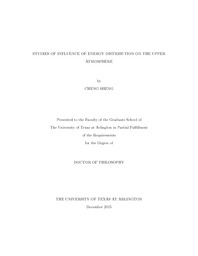| dc.description.abstract | The energy inputs into the upper atmosphere including both solar irradiation and geomagnetic energy can significantly change the upper atmosphere such as the neutral and plasma densities, velocities and temperatures. Therefore, the precise specification of the energy inputs is critical to estimate the ionosphere/thermosphere variation during both quiet and storm times. In order to improve the understanding of the energy distribution and its influence at high latitudes, specifically, we have conducted the following studies. (1) Estimation of the altitudinal distribution of Joule heating from COSMIC observations. Joule heating is the most significant way to dissipate geomagnetic energy at high latitudes. But the altitudinal distribution of Joule heating has not been studied in detail. Based on the Constellation Observing System for Meteorology, Ionosphere, and Climate (COSMIC) observations from 2008 to 2011, the height-integrated Pedersen conductivities in both E (100-150 km) and F (150-600 km) regions and their ratio γP (=γPE/γPF ) have been calculated. The result from data analysis (~5.5) shows a smaller value than that from model (~9), which indicates that the energy inputs into the F region may be underestimated in the model. Dependences of the ratio and the conductance in both E and F regions on the solar and geomagnetic activities have been studied as well. (2) The influence of cusp energy on the thermospheric winds has also been studied, through simulating a real event. The Global Ionosphere Thermosphere Model (GITM) has been run in different cases and under different resolutions to investigate the neutral dynamics around the cusp region. The results indicate that the heating added in the cusp causes the change of pressure gradient around the cusp and changes the neutral wind dynamics there. (3) Correlation of Poynting flux and soft particle precipitation in the dayside polar cap boundary regions has been investigated using DMSP satellite measurements. The signatures of enhanced electromagnetic (Poynting flux) and kinetic (soft electron precipitation) energy deposition in the polar cap boundary regions have been observed previously. But it is not clear how those two different kinds of energy inputs are correlated with each other, which can cause significant difference on the ionosphere/thermosphere response. Our analysis shows that the two energy sources are coincident in some cases, but a clear displacement can also be identified in others, depending on the location and condition. The consequence of the energy displacement has been simulated in the GITM model. These studies will help us get a more comprehensive understanding of how the energy is deposited in the high-latitude upper atmosphere, and how the ionosphere-thermosphere system responds to different energy distributions. | |

